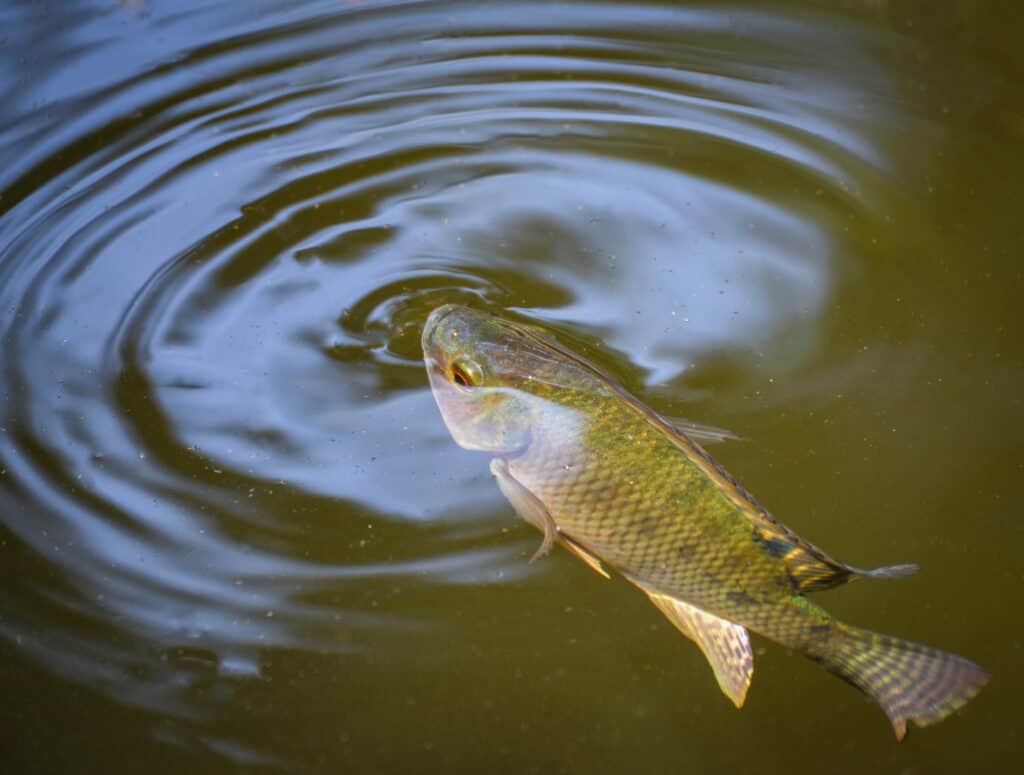Dog owners know that the mere whiff of fish sets a dog off whimpering and begging! The stinkier the better according to Rover and for those readers whose dog has rolled in the rotting remains of a fish, my thoughts are with you! Fish is high in protein and fatty oils that are fantastic for humans and dogs alike, but can dogs eat tilapia the “aquatic chicken” safely?
Let’s find out if it’s safe and what the benefits are.
Is Tilapia Safe For My Dog To Eat?
It’ll come as no surprise that tilapia is safe for dogs to eat if it’s skinned, deboned, and thoroughly cooked without any flavorings like salt, garlic, or other potentially toxic ingredients – more on that later.
If you check out commercial dog food packaging, you’ll see that fish is often a component. That’s because it contains plenty of the nutrients a dog needs to stay fit and healthy.

Tilapia is safe for dogs to eat if it’s skinned, deboned, and thoroughly cooked.
©iStock.com/monkeybusinessimages
What Is Tilapia?
Tilapia (Oreochromis) is a freshwater fish native to Africa. They’ve been introduced to waterways in the US to control aquatic plants such as duckweed in brackish water, so some consider it an invasive fish. However, tilapia available in the store is most likely farmed.
This cheap, mild, and easy-to-prepare fish is the fourth most consumed fish in the US since 2002 behind tuna, salmon, and Alaskan pollock. Its roots hail back to ancient Egypt where it was a symbol of rebirth associated with the goddess Hathor. The Nile tilapia was painted in tombs and mentioned in the Book of the Dead.
Tilapia has earned the nickname “aquatic chicken” due to its mild flavor and popularity, but others describe it as a Franken-fish because it’s been subject to genetic modification in aquaculture in order to keep up with demand.
Now here’s an unusual story. As well as its excellent nutritional properties, tilapia is a medical fish! In California, two black bears caught in wildfires received third-degree burns and were treated with a protective gauze made from tilapia skin. There are also Brazilian trials underway to use tilapia skin on human burns – we await the results!

Tilapia has earned the nickname “aquatic chicken” due to its mild flavor and popularity.
©iStock.com/panida wijitpanya
The Benefits of Tilapia
There are many benefits to tilapia alongside its potential use as a burn treatment. Fish is often included in well-balanced dog foods. Here are some of the benefits of tilapia:
- Protein – tilapia is packed with protein that helps build healthy muscles and repairs muscle damage
- Low in fat – it’s very low in saturated fat meaning it doesn’t pile on many calories
- Phosphorus – repairs tissues and cells and helps the absorption of other nutrients
- Niacin – helps turn food into energy and supports the immune system
- Selenium – protects cells against damage and infections
- Vitamin B – turns food into energy and moves energy and oxygen around the body
- Potassium – maintains fluid levels inside cells
- Omega fatty acids – can help levels of inflammation
- It’s also an alternative source of nutrients for dogs that struggle to digest chicken or pulse sources.
Another great benefit of tilapia is its low mercury levels. This is because it’s a relatively short-lived fish with a diet that’s mostly algae in aquaculture. Because they eat little if any living prey animals, they don’t accumulate much mercury in their tissues.
And last but by no means least, it’s tasty. Dogs love the taste of fish so they eat up their meal without picking and absorb all its goodness. If a dog is off-color, post-op, elderly, or has a reduced appetite tilapia is a good choice to encourage their appetite.
The Risks of Tilapia
Tilapia is chock full of benefits but there’s a few risks too. The good news is the risks are negatable with a bit of work on your part.
The main risk, as with any animal product, is choking on bones or skin.
Choking Risk
Fish bones are small, pointed, and can be quite dangerous to dogs (and cats and humans). Bones can cause mouth wounds and can get lodged in the throat, stomach, and intestines. This leads to a high risk of perforation, internal bleeding, and infection. Not only is this painful and distressing it’s very expensive surgery.
Always prepare tilapia with care, removing the bones and sharp fins. It’s just not worth the risk. If time is short, you can batch-cook and freeze tilapia.
Tilapia skin can also pose a risk, especially to small or young dogs. Skin tends to be chewy and difficult to separate. A large piece can get lodged in their throat and choke your dog, this is particularly true if your dog eats quickly.
Undercooking
Any undercooked animal flesh caries the risk of bacteria like listeria and salmonella. Bacteria can give dogs gastric upsets including diarrhea and vomiting.
Always thoroughly cook tilapia making sure there are no raw parts in the center, and wash your hands because bacteria clinging to raw flesh can make you unwell too.
Some owners feed their dogs a raw diet. This does have some benefits, but speak to your vet first if you’re considering it. A raw diet won’t be suitable for young or old dogs, or any pooch in poor health. You’ll also need a strict cleansing regime to avoid ingesting any bacteria.
Added Flavors
Plain tilapia is good for dogs, but it must be plain! Adding oil can cause gastric illness including pancreatitis that’s very painful, and seasonings like garlic and onion is toxic. Even adding salt can lead to hypertension and cooking tilapia in cow’s milk makes it difficult to digest.
What is the Best Fish for Dogs?
The old saying goes “there are plenty of fish in the sea” and this is true, but some fish are more suitable for dogs than others.
Long-lived carnivorous fish like swordfish and tuna ingest mercury and in turn, your dog is exposed to it. Short-lived fish such as trout and tilapia ingest fewer heavy metals and are therefore less toxic.
Good choices are tilapia, whitefish, catfish, herring, cod, haddock, pollock, and salmon.

Tilapia is a great alternative source of nutrients for dogs that struggle to digest chicken or pulse sources.
©iStock.com/fotyma
How Much Fish Can Dogs Eat?
If your dog is eating a well-balanced commercial dog food it’ll be getting the right amount of nutrients, so tilapia should be given as a treat. The ASPCA suggests treats should make up no more than 10% of a dog’s daily intake.
Even though it’s low fat, too much fish can lead to obesity. The amount varies depending on your dog’s activity levels, but in general sedentary dogs need less calories than active ones.
How To Prepare Tilapia For Dogs
As long as it’s deboned, deskinned, and plain dogs can eat tilapia cooked in most ways. You could bake it, steam it, microwave it, dehydrate it, poach it – any way you please except frying because this involves oil which may lead to diseases like pancreatitis.
What Food Should Dogs Avoid?
Tilapia and other short-lived fish are good for dogs, but there’s a few other foods that are toxic and should always be avoided. If your pooch eats any of the following call a veterinarian immediately
Garlic and Onion
All members of the allium family are toxic because dogs can’t digest their compounds. Instead, the compounds attach to their red blood cells and cause anemia.
Xylitol
This common artificial sweetener is such bad news for dogs it can be fatal within a few hours because it causes hypoglycemia. Xylitol is often found in Jell-o, cakes, biscuits, chocolate, Haribo, and many other sweet treats.
Chocolate
Caffeine, theobromine, and xylitol put so much stress on a dog’s system it can cause organ failure.
Grapes
This cute little fruit can lead to kidney failure even though dogs like the sweetness. Keep grapes and raisins (raisins are dried grapes) well out of reach.
Macadamia nuts
Macadamia nuts contain compounds that dogs can’t digest and this can lead to organ failure. Black walnuts also pose a risk plus they grow a type of toxic-to-dogs mold.
Tilapia is Safe For Dogs To Eat
In conclusion tasty, cheap, and easy-to-prepare aquatic chicken (that’s tilapia!) is good for dogs because it contains plenty of protein, healthy fatty acids, and lots of other nutrients, they also love it!
So long as tilapia is plain, deboned, deskinned, and well-cooked it’s a tasty treat for dogs. Just be sure to keep the amount small if they’re already eating good-quality commercial dog food because obesity causes so many health difficulties and shortens their lifespan.
Up Next
- Can Dogs Actually Eat Brown Rice? What Are The Risks?
- Can Dogs Be Vegan? What Are The Risks?
- Are Lentils Safe For Dogs To Eat?
The photo featured at the top of this post is © iStock.com/chendongshan
Ready to discover the top 10 cutest dog breeds in the entire world?
How about the fastest dogs, the largest dogs and those that are -- quite frankly -- just the kindest dogs on the planet? Each day, AZ Animals sends out lists just like this to our thousands of email subscribers. And the best part? It's FREE. Join today by entering your email below.
Sources
- The Washington Post, Available here: https://www.washingtonpost.com/news/animalia/wp/2018/01/26/two-bears-were-badly-burned-in-wildfires-and-fish-skin-helped-heal-them
- bioRxiv, Available here: https://www.biorxiv.org/content/10.1101/725143v1
- U.S. National Library of Medicine, Available here: https://clinicaltrials.gov/ct2/show/NCT04202289
- Society of Environmental Toxicology and Chemistry, Available here: https://setac.onlinelibrary.wiley.com/doi/abs/10.1002/etc.2883
Thank you for reading! Have some feedback for us? Contact the AZ Animals editorial team.






